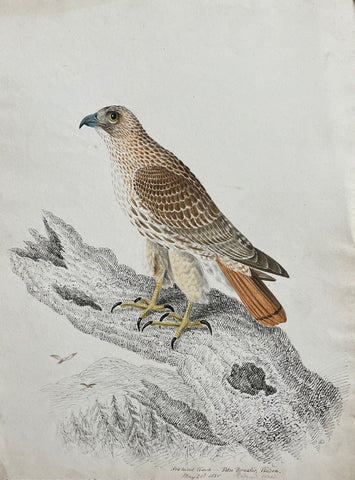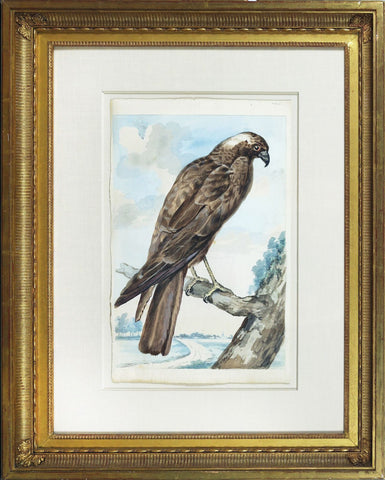
William Pope (British/Canadian, 1811-1902), Red tailed Hawk Falco borealis Wilson May 20th 1835
Red tailed Hawk Falco borealis Wilson May 20th 1835
Pen and ink and watercolor
Signed “W.P” lower right
Paper size: 14 1/2 x 10 1/2 in.
WILLIAM POPE (British/Canadian, 1811-1902)
Canadian ornithological and ichthyological studies
Provenance The artist’s family and thence by descent. Exhibited Simcoe, Ontario, Lynnwood Art Centre, Birds of a Feather, 3-31 May 1987 (a selection). Simcoe, Ontario, Eva Brook Donly Museum, May-7 June 1987 (a selection). Simcoe, Ontario, Lynnwood Art Centre, 4 August-3 September 1989 (a selection) Like his fellow artist-naturalists in the nineteenth century, William Pope was a lover of nature and a sportsman. Contrary to popular belief, sport hunters are, in fact, often passionate about nature and wildlife. They do not see their actions as simply killing the animal but rather about their skill and ability to outwit their prey. The artist and naturalist William Pope was no exception and he enjoyed capturing evocative drawings of North American wildlife while traveling through the wilderness and enjoying the pursuit of the hunt. Born in Kent, England, Pope came to North America for the first time in 1834. He traveled in the United States, eventually moving on to southwestern Ontario on and off through the 1850s, finally settling permanently in Ontario. William Pope is universally considered Canada’s first artist-naturalist. His detailed drawings of birds and other native fauna are often compared to John James Audubon’s works. This collection comes directly from the artist’s family and is the most extensive grouping of Pope watercolors in private hands. Other examples can be found in the Baldwin Collection of Canadiana at the Toronto Public Library.
William Pope made a conscious decision to highlight wildlife by giving the primary subject delicate coloring in watercolor; whereas, the foreground and background are in a monotone pen and ink. The scenes often show a fish or bird on the ground or a shoreline, sometimes with a fishing or hunting scene in the background. The scenes are not generic. The inclusion of figures and sport hunting indicates that it was personal; he intimately knew the landscape, setting, hunting, and species. Small delicate details raise these compositions beyond the documentary checklist of a trophy hunter. Pope includes boats, worms, and small insects for context. Each work is a combination of in-the-field and studio works. There is evidence of erasures he titled them in pencil with common names, then added a more finished formally drawn title in a pale grey (after erasing the pencil writing), then added the Latin Linnean name later in dark brown ink. Pope was familiar with the leading ornithologists and naturalists of the period. He titled many of the works with common and scientific names and noted their sources, such as Linneaus, Bonaparte, and Alexander Wilson. Several unfinished pieces offered here provide some insight into his drawing process. He created the bird first, then devised a complementary foreground and background around it, first in pencil, then in ink.
We Also Recommend





